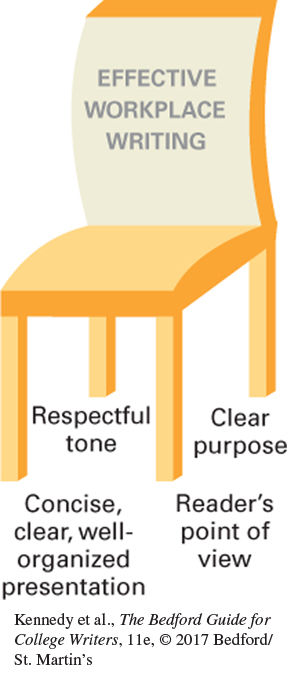Guidelines for Writing in the Workplace

Good workplace writing succeeds in achieving a clear purpose. When you write to a business, your writing represents you; when you write as part of your job, your writing represents your company as well.
Know Your Purpose
Your purpose, or reason for writing, helps you select and arrange information; it sets a standard for measuring your final draft. Most likely you will want to create a certain response in your readers.
DISCOVERY CHECKLIST
Do you want to inform—announce something, update others, explain some specialized knowledge, or reply to a request?
Do you want to motivate some action—get a question answered, a wrong corrected, a decision made, or a personnel director to hire you?
When your readers are finished reading what you’ve written, what do you want them to think? What do you want them to do?
Keep Your Audience in Mind
Consider all your workplace writing from your audience’s point of view. If you don’t know the person to whom you are writing, make educated guesses based on what you know about the position or company. Your purpose is not to express your ideas but to have readers act on them, even if the action is simply to notice your grasp of the situation. To motivate, focus on how “you, the reader” will benefit instead of what “I, the writer” would like.
| “I” ATTITUDE | Please send me the form so I can process your order. |
| “YOU” ATTITUDE | To make sure that you receive your shipment promptly, please send me the order form. |
DISCOVERY CHECKLIST
What do your readers already know about the subject? Are they experts in the field? Have they been kept up to date on the situation?
What do your readers need to know? What information do they expect you to provide? What do they need before they can take action?
What can you assume about your readers’ priorities and expectations? Will they expect a clear, efficient overview or detailed background?
What is most likely to motivate readers to take the action you want?
Use an Appropriate Tone
Tone is the quality of writing that reveals your attitude toward your topic and your readers. If you show readers that you respect them, they are far more likely to view you and your message favorably. Most workplace writing today ranges from the informal to the slightly formal. Gone are extremely formal phrases such as enclosed herewith or pursuant to the stated request. At the other extreme, slang, or a casual, overly friendly style, might cast doubts on your credibility. Strive for a relaxed and conversational style, using simple sentences and familiar words.
Observe business etiquette in courteous writing. If you have a complaint, recall that your reader may not have caused the problem—and courtesy is more likely than sarcasm or insults to motivate help. When delivering bad news, remember that your reader may interpret a bureaucratic response as unsympathetic. And if you have made a mistake, acknowledge it.
REVISION CHECKLIST
Have you avoided slang terms and extremely casual language?
Have you avoided unnecessarily formal or sophisticated words?
Are your sentences of a manageable length?
Have you used the active voice (“I am sending it”) rather than the passive voice (“It is being sent”)?
Does anything you’ve written sound blaming or accusatory?
Do you hear a friendly, considerate, competent person behind your words?
Have you asked someone else to read your writing to check for tone?
Present Information Carefully
For sample business documents, see the figures later in this chapter. For more on adding visuals and formatting job applications, see section F in the Quick Format Guide.
In business, time is money: time wasted reading poorly written material is money wasted. Organize so that readers can move through your writing quickly and easily. Make the topic absolutely clear from the beginning, usually in the first paragraph of a letter or the subject line of a memo or e-mail message. Use the conventional format that readers expect (see Figures 17.3 and 17.5 later in this chapter). Break information into easily processed chunks; order these chunks logically and consistently. Finally, use topic sentences and headings (when appropriate) to label each chunk of information and to give readers an overview of your document.
REVISION CHECKLIST
For more revising and editing strategies, see Ch. 23.
Have you kept your letter, memo, or résumé to a page or two?
Have you cut all unnecessary or wordy explanations?
Have you scrutinized every word to ensure that it can’t be misinterpreted? Have you supplied all the background information readers need?
Have you emphasized the most important part of your message? Will readers know what you want them to do?
Page 341Have you followed a consistent, logical order and a conventional format?
If appropriate, have you included labels and headings?